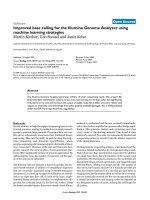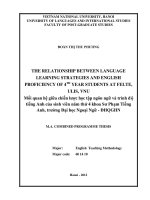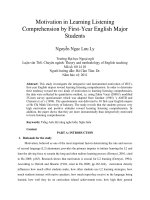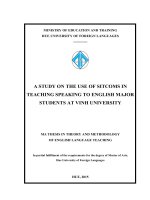Using Language Learning Strategies in Pronunciation Training for Non-English Major Students
Bạn đang xem bản rút gọn của tài liệu. Xem và tải ngay bản đầy đủ của tài liệu tại đây (283.37 KB, 10 trang )
Using Language Learning Strategies in
Pronunciation Training for Non-English
Major Students
Kết hợp sử dụng các chiến lược học tập ngôn
ngữ cùng với huấn luyện phát âm cho sinh viên
không chuyên Anh
Nguyễn Ngân Hà
Trường Đại học Ngoại ngữ
Luận văn Thạc sĩ Chuyên ngành: Phương pháp giảng dạy tiếng Anh; Mã số: 60 14 10
Người hướng dẫn khoa học: Ph.D. Dương Đức Minh
Năm bảo vệ: 2013
Abstract. The purpose of this action research is to improve student’s pronunciation
performance, especially in terms of English vowel sounds, through a pronunciation training
program. There were 20 non-English majored students from Hanoi University of Science,
VNU participating in this program. During 10 weeks, students were provided with
explanation on English vowel production as well as the similarities and differences
between English and Vietnamese vowel systems before practicing these sounds with the
support of Dickerson’s Covert Rehearsal Model. The data were collected from three
questionnaires, two tests - the pre-test and post-test and reflective reports from students.
The analysis of collected data proved that after the training program, students gained
certain improvement in their pronunciation performance. The number of errors in
pronouncing vowels decreased; nevertheless, some sounds remained problematic with
learners. By studying the mistakes, the researcher found that the relationship between L1
and L2 exists and L1 influenced negatively on the L2 pronunciation acquisition of students
in this study. Besides, the use of various pronunciation learning strategies was shown to be
useful for students’ learning of pronunciation, especially the social strategy group (as
classified by Oxford (1990) and Peterson (2000)).
Keywords. Phương pháp giảng dạy; Tiếng Anh
Content.
1. INTRODUCTION
a. Problem statement and rationale for the study
Whether English is learnt as a second language or a foreign language, pronunciation should
be paid adequate attention by both teachers and learners since an English learner with a limited
pronunciation performance may lose his self-confidence in social interactions, which “negatively
affects estimations of a speaker’s credibility and abilities” (Gilakjani, 2012, p. 119). In other
words, learners with good English pronunciation tend to be understood despite their frequent
grammatical mistakes in the speech. On the other hand, good knowledge of English grammar is not
an insurance of intelligibility, meaning “how much of the speech is actually understood by
interlocutors” (Munro, 2011, p.9).
Even though pronunciation is said to be able to acquire naturally (Krashen, 1985),
pronunciation instruction has been proved to bring students chances to enhance their intelligibility
and comprehensibility which are influential factors of their communicative competence (Prator,
1971, Morley, 1991 as cited in Darcy, Ewert, &Lidster, 2012). According to Harmer (2007),
students can overcome difficult sounds by understanding how they are produced while teachers
may support their learning of pronunciation by making them aware of their mispronunciation
(Kenworthy, 1987). In short, pronunciation instruction plays an important role in helping learners
acquire knowledge, raising their awareness and improving skills that support the enhancement of
intelligibility.
With profound influence of the development of English as an international language,
Vietnamese schools are providing students with English as one of the core subjects at school. In
big cities, children even can learn English before they start their primary school (Ha, 2005).
However, it is problematic that “many Vietnamese speakers can speak English, but only a few
have intelligible English pronunciation” (Ha, 2005, p.1). As observed, students in Hanoi
University of Science (HUS) share the same problem. They long to speak English accurately and
fluently but for some reasons, English becomes too challenging for them and they are too shy to
speak English. With the desire to help my students first improve their pronunciation skills and then
consolidate their self-confidence in using English so that the fear of making mistakes or being
blamed will no longer be their obsession, I decide to conduct an action search in which I will
provide my HUS students with frequent pronunciation training combining with pronunciation
learning strategies.
b. Research questions
The study is expected to find answers for the following research questions:
1. Are there any problems of learners when producing English vowel sounds? If yes, what are
they?
2. To what extent does pronunciation training enhance students’ pronunciation performance?
3. What are students’ perceptions of the effectiveness and usefulness of the training?
c. Importance of the study
First and foremost, with the pronunciation training program, the researcher expects to bring
positive changes in students’ pronunciation performance, especially the production of English
vowels. Hence, those who benefit directly from this study are students participating in the research.
After this training, students do not only gain essential knowledge about English pronunciation but
also build up useful learning strategies for themselves to improve their skills. Moreover, it is
hoped that students’ confidence and autonomy will be developed.
Secondly, the findings from this research can be valuable evidence about the relationship of
pronunciation learning strategies and learners’ outcomes, besides showing contribution of explicit
instruction on pronunciation to the improvement of learners. The results of this study might also be
a significant reference for other teachers and researchers that share the same concerned field in
their practice of teaching English.
2. METHODOLOGY
a. Rationale for action research design
Action research is defined as “a process in which participants examine their own
educational practice systematically and carefully, using the techniques of research” (Ferrance,
2000, p.1). This definition raised two key points of action research features. First, action research
is participatory, which means that the researcher conducts an investigation on his/her own teaching
practice, not others’. Second, Ferrance (2000) shares the same viewpoint with Kemmis and
McTaggart (1992) who claim that action research differs from everyday actions of teachers at the
point that action research is “more systematic and collaborative in collecting evidence” (as cited in
Cohen, Manion& Morrison, 2005, p.227).
It was the nature of action research that prevailed the researcher who is also a teacher
having specific problems in teaching pronunciation upon conducting this study. The first reason
comes from the wide range of educational areas where action research can be implemented.
According to Cohen et al. (2005), this type of research may be used in discovering a new teaching
method, improving one’s methods of continuous assessment, continuing professional development
of teachers, encouraging students’ motivation towards learning, etc. By collecting sufficient
evidences, the researcher could identify students’ problems in performing English pronunciation.
This study should have been a survey research if the work had stopped at this phase. However, the
researcher wished to improve the situation after thoroughly understanding what she was facing.
Hence, the very nature of what the teacher or the research was trying to do is problem-solving, not
only problem-identifying. Moreover, with the official investigation into students’ learning
conditions and problems with pronunciation, together with the profound reading of the related
issues in the literature, the researcher developed a practical plan to improve the teaching situation.
Hence, this work was not solely daily problem-solving but as what O’Brien (1998) stated, it was
action research where the researcher has a systematic study on the problem with theoretical
consideration before taking intervention.
b. Participants
This research was conducted in a class with 20 students. In order to understand more about
her students, the researcher delivered a questionnaire to investigate students’ attitude towards
learning pronunciation and their awareness of the problems that they had during their learning
before the training started.
In terms of knowledge about English vowel system, through the questionnaire, fifteen out
of twenty students admitted that they could not remember all sounds and their symbols. There
were only four of them able to give precise answers while the percentage of students identified
more than 80% of vowel sounds correctly was just under 50%. Particularly, five among 20
students could remember only three to five symbols of vowel sounds.
In terms of problems in learning and practicing English pronunciation, the vast
majority of participants stated that they could not identify their pronunciation mistakes while
speaking. In addition, many students (13 out of 20) were pessimistic about their pronunciation
when emphasizing that they found it difficult to pronounce sounds correctly. The same number of
students realized the influence of Vietnamese sounds while producing English sounds. Especially,
none of students were satisfied with their pronunciation performance at that time. However,
despite existing problems, they admitted that they had never spent time practicing English
pronunciation regularly. Luckily, every student recognized the necessity of enhancing their
pronunciation skills. This need may be turned into students’ motivation in learning.
3. FINDINGS
a. Research question 1: Are there any problems of learners when producing English vowel
sounds? If yes, what are they?
Problematic sounds that most students made can be divided into two main groups. The first
group includes incorrect sounds due to the tendency of replacing an English vowel with another in
Vietnamese. The second group consists of mispronounced letters caused by using incorrect sound
for its representing letter in English.
Group 1: Incorrect pronunciation of sounds resulting from the replacing an English vowel with
another in Vietnamese
As a matter of fact that the vowel / æ / does not exist in Vietnamese, students who could
not pronounce the sound correctly tended to replace it with the sound /e/ that is the common vowel
of Vietnamese and English languages. Another problematic sound was /ʌ/ in words “ sun” or
“son” /sʌn/, “ wonderful” /ˈwʌndəfl/ and “some” /sʌm/. It is interesting to note that not every
word with this sound was mispronounced, for example, the word “sun” or “son” and “some”.
However, students failed to pronounce the vowel /ʌ/ when it was in the word “wonderful” and
changed it into the sound /uə
̯
/ (the representing letters are “uô” in Vietnamese”).
A very common problem appeared in the recorded speech by most of the students in this
study is the mispronunciation of the sounds /əʊ/ and /ə/. Despite the fact that the sound /əʊ/ does
exist in the Vietnamese vowel system, almost all students participating in this research pronounced
the letter “o” in “home” or “most” as /o/ (represented by the letter “ô” in Vietnamese).
Nevertheless, they could correctly pronounce the word “cold”. The similar replacement happened
with the sound /ə/ represented by the letter “o” as in “European”. In this case, the pronunciation of
this word changed into /ˌjʊəroˈpiːən/.
Moreover, as in the case of the word “home”, when it appeared many times in the tests,
students also had the similar problem with the sound /əʊ/. This means that the wrong
pronunciation may become a habit of learners when they are not noticed about the mistake.
Group 2:Mispronounced letters caused by using the wrong sound for its representing letter in
English
* Problems with letter “a”
When pronouncing the word “Pacific” in the text of the two tests, students could not decide
which is the correct way to pronounce it and many incorrect ways of pronouncing this letter were
observed. The exact sound for the letter “a” in this case is /ə/ as the stress falls on the second
syllable. However, 13 out of 20 students in the pre-test failed to make it right. 9 out of these
students used the sound /a/ (represented by letter “a” in Vietnamese) to apply for the letter. In the
meantime, 3 students pronounced it as /eɪ/ which is one of the sound represented by “a” in English
like in “make” or “cake”. Especially, there was a student pronouncing “a” as /e/ which may not
very common in English.
* Problems with letter “i”
In English, “i” can represent a variety of sounds such as /ɪ/ in “fish”, “film”, “him”, /i:/ in
“police” or /aɪ/ in “find”, “bike”, “wide”, etc. Therefore, it was easy to understand why the
students in this study confused when deciding whether to choose /ɪ/ or /aɪ/ to pronounce the letter
in the tests. After all, they put /ɪ/ for “i” instead of /aɪ/ or vice versa. For example, letter “i” in
“wine”, “lifestyle” or “nightlife” should be pronounced as /aɪ/ but about 5 to 6 students used /ɪ/
wrongly. In contrast, more than half of students pronounced the word “liberal” incorrectly as they
thought /aɪ/ was the right sound.
* Problems with letter “e”
With this letter, the most frequently-mispronounced words are “incredible” /ɪnˈkredəbl/ and
“valley” /ˈvæli/. Regarding the pronunciation of “incredible”, the first letter “e” was pronounced as
/ɪ/ instead of /e/ by one-third of students in the pre-test. This number reduced to three students in
the post-test. Letter “e” in “valley” was mispronounced as /ei/ by 70% of students (equal to 14
students) in the pre-test and 8 students in the post-test.
b. Research question 2: To what extent does pronunciation training enhance students’
pronunciation performance?
The answer to this question is based on the comparison of the scores of the pre-test and
post-test. The T-test had been used to analyze the results of the two tests. It suggests that after the
training course, students gained a significant improvement in their vowel sound production. In
other words, students became more aware of their problems and managed to produce English
vowels more
c. Research question 3: What are students’ perceptions of the effectiveness and usefulness of the
training?
On the one hand, many students stated that the training provided them with skills and
knowledge of English vowels so their pronunciation developed quickly. On the other hand,
students admitted that their improvement in English vowel pronunciation was not so clear. Some
students put that gaining development in pronunciation was of great importance for him/her as
he/she could better their listening skill if he/she had correct pronunciation. Nevertheless, there
were also students not finding much development in pronunciation after the training.
In most of the reflective reports, students reflected that the teacher’s instruction on
pronouncing vowel sounds in class brought a lot of benefits for them. Firstly, they could
pronounce the sound more correctly thanks to knowing how to produce it. Secondly, students
found it more interesting and motivated when they were learning how to articulate a sound
correctly.
Besides comments on in-class training, students also expressed their viewpoints about their
practice progress with Covert Rehearsal Model. The most-appreciated aspect of this model was
that students had chances to hear their voice, share the recording of their voice in class and receive
feedbacks from the teachers and other classmate. According to them, learning from mistakes is a
beneficial way of improve English pronunciation.
4. DISCUSSION
a. The necessity of explicit English pronunciation instruction
The findings of this study provide strong support for including explicit English
pronunciation explanation in the teaching syllabus. Appreciation from students on the
pronunciation instruction suggests that they can benefit from the formal teaching of English
vowels. The profits that students can gain from pronunciation lessons are not only the knowledge
of how to produce the correct sounds but also the raising of their awareness.
b. The awareness of contrasts between English and Vietnamese sound system
The analysis of students’ problematic sounds in the pre-test and post-test have once again
proved the relationship between L1 and L2. According to Odlin (1989, as cited in Ly, 2007) and
Celce-Murcia, et al. (1996), the influence of L1 on L2 can be reflected in the phenomenon that L2
learners tend to replace an L2 sound that does not exist in their L1 with an L1 similar sound. In this
study, the tendency of replacing an English vowel with another Vietnamese sound was one of the
causes for students’ mispronunciation. Therefore, when teaching English pronunciation, the
teacher should notice students about the possible influence of their native language on the
pronunciation of English sounds. Moreover, the teacher can study more thoroughly on the
problems which are caused by the negative transfer of L1 to L2. This can help him/her understand
the root of students’ mispronunciation due to the impact of L1.
c. The notice of the relationship between English spelling and sound systems
Each language has its own feature and so does English. However, some of its features can
actually cause difficulties for learners (Kelly, 2001). In this study, the trouble arose from the
mismatch between English spelling and sounds. In English, one sound can be represented by many
letters and one letter may have different ways of pronunciation. Therefore, there might be
confusion of students in selecting the correct pronunciation for a letter. Some special features of
the English spelling and sound systems should be informed to students so that they will not be
surprised when observing a rule the different from their native language.
5. CONCLUSION
The study was aimed at investigating whether the pronunciation training program could
support students in learning English vowels or not and to what extent. First of all, some major
types of students’ problems in pronouncing English vowels have been identified. The most
common problems fall into two groups. The first group includes mispronounced sounds due to
students’ wrong replacement of English vowel sounds with other Vietnamese vowels. The second
group reveals students’ confusion in pronouncing a representing letter correctly due to some
special features of English language. As an English letter has several sounds to represent,
Vietnamese students encounter difficulties in selecting accurate pronunciation. Secondly, analyzed
data from the two tests as well as the reflective reports have proved that the training program
helped students improve their pronunciation of English vowel sounds. However, its usefulness was
not always clear. In general, students made fewer mistakes in pronouncing words but there were
some problems that still remained after the training.
Studies on the use of learning strategies in pronunciation still remain very few. More
attention to this field should be encouraged as teaching and learning pronunciation are of great
importance in supporting other practical skills in English. Further research can be done with the
same framework of the pronunciation training program in this study to re-examine the actual
benefit of formal instructions of English sounds and the Covert Rehearsal Model. Those studies
can continue working with consonants or other elements of English suprasegmentals.
References.
Cohen, L., Manion, L. & Morrison, K. (2005).Research Method in Education (5
th
ed.).
RoutledgeFalmer. London.
Darcy, I., Ewert, D. &Lidster, R. (2012).Bringing Pronunciation Instruction back into the
Classroom: An ESL Teachers’ Pronunciation “Toolbox”.In. J. Levis & K. LeVelle
(Eds.).Proceedings of the 3rd Pronunciation in Second Language Learning and Teaching
Conference, Sept. 2011. (pp. 93-108). Ames, IA: Iowa State University
Ferrane, E. (2000). Action Research.Brown University.
Gilakjani, A.P. (2012). The Significance of Pronunciation in English Language Teaching.English
Language Teaching, 5(4), 96-107.
Ha, C. T. (2005). Common Pronunciation Problems of Vietnamese Learners of English.Journal of
Science.Foreign Languages.T.XX1. No. 1. 35-46
Harmer, J. (2007).The Practice of English Language Teaching(4th ed.). Harlow: Pearson
Longman.
Kelly, G. (2001). How to Teach Pronunciation. Pearson Education Limited.
Kenworthy, J. (1987).Teaching English Pronunciation. Harlow: Longman.
Krashen, S.D. (1985). Language Acquisition and Language Education.Prentice Hall, Englewood
Cliffs.
Ly, H. L. (2007). Pronunciation: A Study of Vietnamese EFL Learners.Master’s Thesis.Available
from ProQuest Dissertations and Thesis database. (UMI No. 1451047).
Munro, M.J. (2011). The Intelligibility Construct: Issues and Research Findings. Center for
Intercultural Language Studies Series. University Of British Columbia, Canada.
O’Brien, R. (1998). An Overview of the Methodological Approach of Action Research.University
of Toronto. Retrieved on 30
th
December 2012 from:









